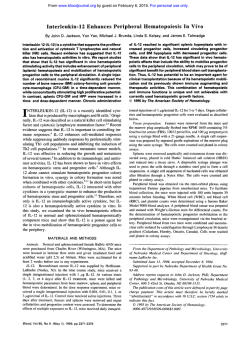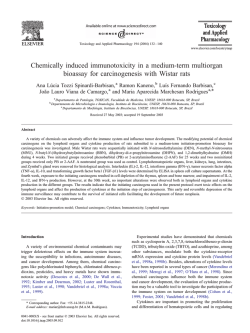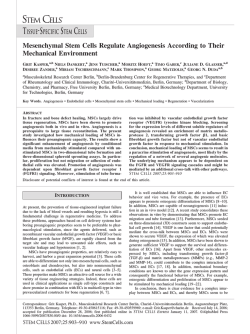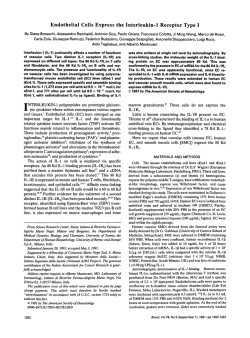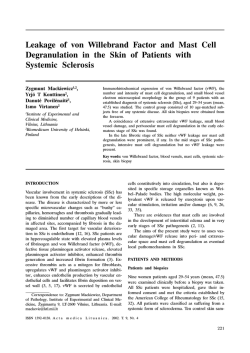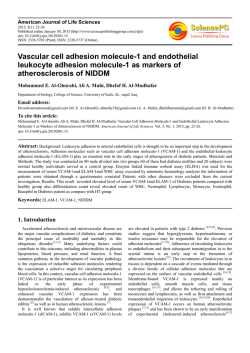
Inhibition of Angiogenesis by Interleukin-12 Is Mediated by
Inhibition of Angiogenesis by Interleukin-12 Is Mediated by the
Interferon-Inducible Protein 10
By Cecilia Sgadari, Anne L. Angiolillo, and Giovanna Tosato
Interleukin 12 (IL-121, a multifunctional cytokine produced
by macrophages and B-cell lines, induces interferon-y (IFNy ) production, stimulatea growth of both T and natural killer
cells, promotes Thl-type helper T-cell responsas, and inhibits neovascularization. Because the human interferon-inducible protein 10 (IP-10) can also inhibit neovascularization,we
tested whether IP-IO, induced by 11-12 through the intermediate IFN-y, might be a mediator of IL-12 angiogenesis inhibition. We report here that murine IL-12 profoundly inhibited
basic fibroblast growth factor (bFGF)-induced Matrigel neovascularization in vivo, and that this effect of IL-12 was neu-
tralized by systemic administration of antibodies to either
murine IFN-y or IP-10. Murina IL-12 induced murine IP-10
expression in mouse splenocytes, and human IFN-y inducad
human IP-10 expression in purified human endothelial cells,
suggesting that IL-12 can induce IP-10 expression in certain
cells. These results document the important role of IP-10 as
a mediator of angiogenesis inhibitionby IL-12, and raise the
possibility that IP-10 may also contribute to the antitumor
effect of 11-12.
This is a US government work. There are no restrictions on
its use.
I
(Cambridge, MA). Rabbit antimurine IP-10 antibody4’was a gift of
J.M. Farber (Laboratory of Clinical Investigation, National Institute
of Allergy and Infectious Diseases, NM, Bethesda, MD). A control
rabbit serum was obtained from animals immunized with a human
IL-6peptide. A mouse monoclonal antibody (MoAb) to murine IFNy4’ was a gift of David Finbloom (Center for Biologics Evaluation
and Research [EBER], Bethesda, MD). A control mouse MoAb
(specific for human IgG) was purchased from Cappel (Organon
Technika Co, Durham, NC). bFGF was purchased from R&D Systems (Minneapolis, MN). Human umbilical vein endothelial cells
(HUVEC), obtained from the American Type Culture Collection
(Rockville, MD), were maintained in RPMI 1640 medium (GIBCO
BRL, Gaithersburg, MD), 15% heat-inactivated fetal bovine serum
(Intergen Co, Purchase, NY), 20 U/mL porcine preservative-free
heparin (Squibb-Marsham, Inc, Cherry Hill, NJ), and 100 pg/mL
endothelial cell growth supplement (ECGS; a crude extract of bovine
neural tissue containing bFGF and acidic F G F Calbiochem-Novabiochem Corp, La Jolla, CA).
In vivo matrigel assay. This assay was performed as described.”
Briefly, Matrigel (liquid at 4°C) was mixed with 150 ng/mL bFGF
alone or in combination with either IP-10or IL-12at a final concentration of 400 ng/mL and 100 ng/mL, respectively. Matrigel alone,
with bFGF, or with bFGF plus the test cytokine (total volume 0.5
mL), was injected subcutaneously into the midabdominal region of
BALBk nude mice. After injection, the Matrigel polymerized to
form a plug. After 6 days, the animals were killed, and the Matrigel
plugs were removed together with the abstract epidermis and dermis,
fixed in 10% neutral buffered formalin solution (Sigma Chemical
NTERLEUKIN-12 (IL-l2), a disulfide-linked hetero-
dimer composed of two subunits with molecular masses
of 35 kD and 40 kD, is a multifunctional cytokine produced
by macrophages, B-cell lines, and other cells.’-6L-12 was
shown to stimulate the proliferation of activated T and natural killer (NK) ~ells,’*~*~.’
to enhance specific and nonspecific
cytolytic lymphocyte
to induce interferon-y
(IFN-y)production by NK and T
and to promote
the development of Thl-type helper T cell responses.”-’3 In
murine models, IL- 12 demonstrates antitumor activity toward a variety of experimental malignancie~’~.’~
and exerts
antimicrobial and antifungal activity toward various infectious
Recently, IL-12 was reported to inhibit angiogenesis in
an in vivo mouse model of corneal neovascularization induced by basic fibroblast growth factor (bFGF).Z2.23
Because
this inhibition was neutralized by antibodies to IFN-y, it
was concluded that the antiangiogenic activity of IL-12was
attributable to IFN-yinduced by IL-12.”But the effects of
IFN-y on angiogenesis have been variable, and both stimulation and inhibition of angiogenesis have been reported in
different experimental systems.w2*
Several other compounds have been reported previously
to inhibit angiogenesis in vitro andor in vivo, including
thromb~spondin?~platelet factor (PF) ’4;
transforming
protamine,33fumagillin,34
growth factor p (TGFp),3’ IL-l,32
the tissue inhibitor of metalloproteina~e:~a n g i ~ s t a t i nand
,~~
the human pregnancy hormone HCG.37 Recently, we and
others have reported that the interferon inducible protein 10
(IP-lo),a member of the a chemokine family, is an inhibitor
of angiogenesis in v ~ v o . ~ Because
’,~~
IP-10 is induced by
IFN-y,and IL-12 is a potent inducer of IFN-y,we have
tested the possibility that IL-12might inhibit angiogenesis
indirectly, through induction of IFN-yand, secondarily, IP10.
MATERIALS AND METHODS
Mice, cells, reagents, and cytokines. Four- to six-week-old female BALBk nu/nu mice (National Cancer Institute, National Institutes of Health [NIH], Frederick, MD or Taconic, G e m t o w n , NY)
maintained in pathogen-limited conditions were used throughout.
Matrigel was prepared by H.K. Kleinman from the EnglebrethHolm-Swarm tumor as previously described.” Recombinant human
IF’-10 (0.06 endotoxin U/mg; Pepro Tech, Inc, Rocky Hill, NJ) was
either purchased or provided by the National Cancer Institute. Recombinant murine IL-12 was a kind gift of Genetics Institute, Inc
Blood, Vol 87, No 9 (May 1). 1996: pp 3877-3882
From the Division of Hematologic Products, Center for Biologics
Evaluation and Research, Food and Drug Administration, Bethesda,
MD; and the Department of Hematology/Oncology, Children’s National Medical Center, Washington, DC.
Submitted October 11, 1995; accepted December 19, 1995.
Supported in part by an appointment to the Postgraduate Research
Participation Program at the Center for Biologics, Evaluation and
Research administered by the Oak Ridge Institute for Science and
Education through an interagency agreement between the US Department of Energy and the US Food and Drug Administration
C.S. and A L A . contributed equally to this work.
Address reprint requests to Cecilia Sgaabri, MD, CBEWFDA
(HFM-535),Bldg 29A, Room 2006, 8800 Rockville Pike, Bethesda,
MD 20892.
The publication costs of this article were defrayed in part by page
charge payment. This article must therefore be hereby marked
“advedsement” in accordance with 18 U.S.C. section 1734 solely to
indicate this fact.
This is a US govenunent work. There are no restrktions on its use.
ooW-4971/96/8709-0029$0.00/0
3877
3878
SGADARI, ANGIOLILLO, AND TOSATO
Table 1. PCR Primers, Product Sizes, and Annealing Temperatures
Genbank
Accession no.
Primer Pair
(upper strand; lower strand)
m-IP-IO
M86829
m-IFN-y
M28621
m-G3PDH
M32599
h-IP-IO
X02530
h-IFN-y
M29383
ACCATGAACCCAAGTGCTGCCGTC;
GCTTCACTCCAGTTAAGGAGCCCT
TGCGGCCTAGCTCTGAGACAATGA;
TGAATGCTTGGCGCTGGACCTGTG
GCCACCCAGAAGACTGTGGATGGC;
CATGTAGGCCATGAGGTCCACCAC
GGAACCTCCAGTCTCAGCACC;
CAGCCTCTGTGTGGTCCATCC
TGGGTTCTCTTGGCTGTTACTGCC;
TACTGGGATGCTCTTCGACCTCGA
RNA Detected
Size (bpl
Temperature
31 1
64
413
64
446
56.5
375
55
453
64
("C)
Abbreviations: m, murine: h, human
Co, St Louis, MO), and embedded in paraffin. Histological sections
were stained with Masson's trichrome. The cell-occupied area in
the histological sections was measured using a computerized digital
analyzer (Optomax, Hollis, NH).
Neutralization experiments. In vivo neutralization experiments
were performed by coinjection of a neutralizing or control antibody
together with the Matrigel plus bFGF plus IL-12 injection mixture,
followed by treatment of the mice with intraperitoneal (i.p.) injections of the same neutralizing or control antibody on days 1, 3, and
5 after subcutaneous Matrigel injection. The neutralizing murine IgG
MoAb to murine I F N - Y and
~ ~ the control murine IgG MoAb (Cappel)
were added individually to the Matrigel injection mixture (0.5 mL
Matrigel plus 150 ng/mL bFGF plus 100 ng/mL murine IL-12) at a
final concentration of 1 mglmL; they were also injected individually
i.p. at a dose of 1 mg/mouse in 0.3 mL of a formulation buffer
(saline solution containing 50 mg/mL human serum albumin and 5
mg/mL mannitol; a gift of Dr J. Henkin, Abbott Laboratories, Abbott
Park, IL). The neutralizing rabbit antiserum to murine IP-104' and
the control rabbit antiserum (antihuman IL-6 peptide) were added
individually to the Matrigel injection mixture at a dilution of 1:10;
they were also injected individually ip (0.3 Wmouse) on days 1,
3, and 5 after subcutaneous Matrigel injection.
Isolation of RNA and reverse transcriptase-mediated polymerase
chain reaction (RT-PCR). Total cellular RNA was isolated from
either murine splenocytes or HUVEC by the guanidine thiocyanate/
CsCl centrifugation method, as described.43 Levels of cytokine
mRNA were assessed by a semiquantitative RT-PCR as described.43
Briefly, RNA (4 pg) was reverse transcribed, using an Rnase Hreverse transcriptase (Superscript; Life Technologies, Inc, Gaithersburg, MD) according to the manufacturer's conditions. The resultant
cDNA was immediately diluted with HzO to a final volume of 200
pL, without heating or Rnase H treatment. PCR was performed in
thin-wall reaction tubes (Perkin Elmer Cetus, Norwalk, CT) in a
reaction mixture (50 pL) containing cDNA, 200 pmol/L each dNTP,
1 pCi a-[32P]dCTP(3,000 CUmmol; Dupont-NEN, Boston, MA), 1
pmol/L each primer, 5% dimethyl sulfoxide (DMSO; Sigma Chemical Co), 1.5 mmoVL MgC12, and 2.5 U AmpliTaq DNA polymerase
(Perkin Elmer Cetus) in reaction buffer supplied by the manufacturer. Primers are listed in Table 1. The number of amplification
cycles chosen empirically for each primer pair was such that the
maximum signal intensity for a set of samples was within the linear
portion of a product versus template amplification c ~ r v e . 4Amplifi~
cations were performed in a thermocycler (Gene Amp PCR System
9,600; Perkin Elmer Cetus) as follows: 94"C, 45 seconds; primer
annealing temperature as specified in Table 1,45 seconds; 72°C 45
seconds); and maintenance at 4°C until analysis. Aliquots (50 pL)
of each amplification reaction were analyzed by electrophoresis on
7% acrylamide (Long Ranger; AT Biochem, Malvem, PA) Tris-
borate EDTA gels, followed by autora&ography and quantitation
by Phosphorimage analysis (Molecular Dynamics, Sunnyvale, CA).
DNA sizes were determined using mobility standards derived by
T4 DNA polymerase end-labeling of Gel Marker DNA (Research
Genetics, Huntsville, AL).
Statistical analysis. Arithmetic means, standard deviations, and
Student's t-test were calculated by conventional formulas using Systat for the Machintosh (Systat Inc, Evanston, IL).
RESULTS
In initial experiments, we tested the effects of IL-12 on
neovascularization using a mouse model in which subcutaneous injection of basement membrane (Matrigel) impregnated
with bFGF induces new vessel formation. Athymic mice,
selected to exclude potential contributions by immune T
cells, were injected subcutaneously with Matrigel alone, Matrigel plus bFGF (150 ng/mL), Matrigel plus bFGF (150 ng/
mL) plus human IP-10 (400 ng/mL), or Matrigel plus bFGF
(150 ng/mL) plus murine IL-12 (100 ng/mL), all in a final
volume of 0.5 mL. Matrigel plugs, removed from the mice
6 days after injection and processed for histology, were analyzed for cell invasion. Previous studies have established
that the cells invading bFGF-impregnated Matrigel plugs are
mostly endothelial cells." In a representative experiment
(Fig l), plugs of Matrigel alone contained few infiltrating
cells, accounting for a mean surface area of 104 pm2/field
(4 X lo4 pm'). Matrigel plugs impregnated with bFGF contained 12.4-fold more infiltrating cells compared with plugs
of Matrigel alone (mean surface area 1,290 pm'/field), indicative of bFGF-induced neovascularization. Matrigel plugs
with IL- 12 added together with bFGF contained significantly
fewer cells compared with Matrigel plus bFGF plugs (mean
surface area 269 pm'held, P < .001). These results are
indicative of IL- 12-induced inhibition of neovascularization. As reported previously, IP-10 suppressed bFGF-induced neovascularization of Matrigel plugs (mean surface
area 412 pm2/field). These experiments confirm, in another
model system, that IL-12 can act as a potent inhibitor of
neovascularization in vivo. Because these studies used
athymic mice, the results further indicate that the antiangiogenic effect of IL-12 is not dependent on the participation
of immune T cells.
To assess whether the antiangiogenic activity of IL-12
could be caused by IP-10 induction, we first looked for IFN-
INHIBITION OF ANGIOGENESIS BY IL-12
3879
1Mo.
loa0
500
0
Matrigel
Matrigel +
bFGF
Matrigel +
bFGF+
IL-12
Matrigel +
bFGF+
IP-10
Fig 1. In vivo effects of 11-12 and IP-10 on endothelial cell invasion
of Matrigel. Female BALBlc nulnu mice were injected subcutaneously with either Matrigel alone, Matrigel plus bFGF, Matrigel plus
bFGF and murine IL-12, or Matrigel plus bFGF and human IP-10. Plugs
were removed 6 days after injection and processed for histology,
and angiogenesiswas quantified. The results are expressed as mean
Matrigel surface area lpm21occupied by cellslfield (4 x 10' pm21.
Each data point reflects the mean ( S D )surface area in groups of
three mice; six readings on nonoverlapping Matrigel fields were
quantitated per plug.
y and IP-IO gene expression in athymic mouse splenocyte
cultures induced with murine IL-12. To this end, splenocytes
(3 X IOh cells/mL) from two 6-week-old BALB/c nuhu
mice were incubated for 5 to 30 hours in either medium
alone, LPS (100 ng/mL), or IL-12 ( I O ng/mL). At the end
of culture, the presence of IFN-y and IP-IO mRNAs was
assessed through reverse transcription and PCR amplification using specific primers followed by gel electrophoresis
of the PCR products. The results show that murine IL-12
induces both murine IFN-y and murine IP-IO gene expression in splenocytes after 5 , 24, and 30 hours of exposure
(Fig 2A). Because both IFN-y and IP-IO mRNAs were detectable at the earliest time point (5 hours) tested after IL12 stimulation, a temporal relationship between IFN-y and
IP-IO induction by IL-12 could not be established. However,
primary cultures of human umbilical cord endothelial cells
(HUVEC) were incubated in medium alone, or in medium
supplemented with either human IL-12 ( I O ng/mL) or human
IFN-y (I00 ng/mL) to assess whether IFN-y is required for
IP-IO gene expression. Cultures were obtained after a 6- or
24-hours incubation. RNA was extracted, and expression of
human IP-IO was examined after reverse transcription and
PCR amplification using specific primers. IFN-y induced
IP-IO expression in HUVEC at both time points whereas IL12 did not (Fig 2B). Consistent with the notion that endothelial cells are not a source of IFN-y, IL-I2 did not induce IFNy mRNA expression in HUVEC (not shown). This failure of
IL-12 to induce IP-IO expression in HUVEC could not be
attributed to IL-12 being inactive because in parallel assays
human IL-I 2 stimulated appropriately phytohemagglutinin
(PHA) preactivated T cells (not shown). These findings show
that IL-12 can stimulate IP-IO and IFN-y expression in
splenocyte cultures. and suggest that IL- 12 cannot induce
IP-IO expression in endothelial cells directly. but rather
through the intermediate IFN-y.
The observation that murine IL-12 is an inducer of murine
IP-IO in vitro suggested the possibility that IL-12. present
within the Matrigel. might also induce IFN-y and IP-IO
production locally. If so. the antiangiogenic effect of IL-I2
could be indirect. and result from secretion of IP-IO. a known
inhibitor of angiogenesis in vivo.3x."' Therefore. we assessed
the effects of murine IL-12 on angiogenesis in vivo in mice
simultaneously treated with neutralizing antibodies to either
murine IFN-y or IP- IO. As shown (Table 2). in each of three
mice, a neutralizing mouse MoAb to murine IFN-y. but not
a control antibody, abolished IL-l?-induced inhibition of
neovascularization (results with the MoAb to IFN-y are significantly different from those without antibody or with the
control MoAb: P < .OOO2 in each case). This finding shows
that IL-12 requires IFN-y to inhibit angiogenesis in this
system. In addition. a rabbit antiserum to murine IP-IO reduced IL- 12-induced inhibition of neovascularization from
82.8% to only 2 1.2%. indicative of a prominent role played
by IP-IO in this process (results with the antiserum to IP-IO
are significantly different from those without the antibody.
P = .OO3, or with the control antiserum. P = .O3). Consistent
with our previous findings.jx IP-IO at 400 ng/mL inhibited
bFGF-inhibited neovascularization of Matrigel plugs by
52%. These results confirm that the antiangiogenic effects
of IL-12 are entirely mediated by IFN-y." and further establish the important role played by IP-IO as a downstream
mediator of inhibition of neovascularization by IL- 12.
DISCUSSION
The present experiments show that IP-IO is the downstream molecule primarily responsible for inhibition of angiogenesis by IL- 12. In addition, these experiments confirm
that inhibition of angiogenesis by IL-12 is mediated by IFNY , ~ ' an inducer of IP-IO.Js.J" In these experiments. the antibody to murine IFN-y completely neutralized the effects of
IL- 12, whereas the antiserum to murine IP- I O substantially
reduced. but not completely removed. IL- I2 inhibition. Also.
IL-I2 inhibited angiogenesis to a somewhat greater extent
than IP-IO. One interpretation of these experiments is that
IL-12 is a more potent inhibitor of angiogenesis than IP-IO.
capable of inducing IP-IO along with other IFN-y-inducible
antiangiogenic compounds, and perhaps IFN-y itself. If so.
it is interesting to note that the angiogenesis inhibitor PF4.
a member of the (Y chemokine subfamily like IP-IO. is not
induced by IFN-y:'
and that the IFN-y-inducible chemokines Mig and IL-8 did not display antiangiogenic activity
in preliminary in vivo assays.j" In addition. results with IFNy have been variable.2J"Xand when IFN-y treatment caused
inhibition of angiogenesis. IP- IO, induced by IFN-y in endothelial cells, could have been involved. However. it is still
possible that compounds other than IP-l 0. induced directly
SGADARI, ANGIOLILLO, AND TOSATO
3880
--A
5 hours
24 hours
30 hours
IP- 10
-B
6 hours
24 hours
INF-'{
I P - 10
G3PDH
G3PDH
Fig 2. Effects of IL-12 on IFN-y and IP-10 gene expression. (A) Splenocytes (3 x 106/mL) were cultured for 5, 24, and 30 hours in either
medium alone or medium supplemented with murine IL-12 (10 ng/mL) or lipopolysaccharide (100 ng/mL). At the end of the culture, RNA was
extracted and analyzed by RT-PCR. Amplification cycles used were as follows: murine IP-10. 22 cycles; murine IFN-y, 30 cycles; and GBPDH,
21 cycles. IBI Confluent monolayers of HUVEC were cultured for 6 or 24 hours in either medium alone or medium supplemented with either
human IL-12 (10 ng/mL) or human IFN-7 (100 ng/mL). After culture, RNA was extracted and analyzed by RT-PCR. Amplification cycles were
as follows: human IP-10. 22 cycles; and G3PDH. 21 cycles.
or indirectly by IL-12, contribute to inhibition of angiogenesis by IL-12. An alternative possibility is that the IP-IO used
here may not express its full biologic potential, andor that
the antiserum to murine IP-IO may not display optimal neuTable 2. Effects of Neutralizing Antibodies t o Murine IFN-7 or IP-10
on IL-12-Induced Inhibition of Endothelial Cell
Invasion of Matrigel In Vivo
Mean Surface
Area (pm')
Occupied by
Additions to
Matrigel
% Inhibition of
CellsField (zSD) Neovascularization
456
2,795
858
1,673
None
bFGF
bFGF + IL-12
bFGF + IP-10
bFGF + IL-12
bFGF + IL-12
bFGF
bFGF
+ anti-IFN-y
IgG
+ mouse IgG
+ IL-12 + anti-IP-10
+ IL-12 + rabbit serum
-
(252)
(546)
(288)
(242)
82.8
52.0
3,309 (308)
682 (177)
0
90.3
2,299 (555)
1,179 (212)
21.2
69.1
-
BALB/c nu/nu female mice (3 mice per condition) were injected
subcutaneously with either Matrigel alone, Matrigel plus bFGF (150
ng/mL), Matrigel plus bFGF (150 ng/mL) and murine IL-12 (100 nglml)
alone or together with control or neutralizing antibodies to either IFNy or IP-10. or Matrigel plus bFGF (150 ng/mL) and human IP-10 (400
ng/mL). The mice injected subcutaneously with Matrigel plus IL-12
plus antibodies were also injected intraperitoneally with the appropriate antibodies on day 1 and again 3 and 5 days later. The Matrigel
plugs were removed 6 days after inoculation and processed for histology. The results reflect the mean (+SD) surface area (pm2)occupied
by cells/field (4 x 10' pm2)for each group of mice.
tralizing capacity for murine IP-IO. at least in comparison
to the anti IFN-7 antibody used in parallel.
Only recently has inhibition of angiogenesis been identified as a biologic property of IP-10:~"~"'In two distinct in
vivo models, the rat corneal micropocket and the mouse
Matrigel models, IP-IO in nanogram quantities inhibited neovascularization induced by either IL-8 or bFGF. Although
the mechanisms underlying this biologic property of IP-IO
have not been investigated in detail. in vitro data have shown
that in nanogram concentrations IP- IO can inhibit endothelial
cell chemotaxis3Yand differentiation into tubelike structures,3Xbut does not affect cell proliferation.3X.JX
Microgram
concentrations of IP- IO were required for endothelial cells
to be growth inhibited.JXsuggesting that unlike other inhihitors of angiogenesis, IP- IO may not suppress neovascularization primarily through regulation of endothelial cell proliferation.
Other biologic properties attributed to 1P-IO include inhibition of colony formation by human bone marrow hematopoietic cells? chemoattraction of human monocyte and activated T cells,5"stimulation of T-cell adhesion to endothelial
cells, suppression of tumor growth in vivo,5' and calcium
flux in activated T lymphocytes." Because a variety of cell
types, including mononuclear cells, fibroblasts, keratinocytes, endothelial cells, and T cells. are known to express
the IP-IO gene in response to IFN-7 or to other signals?'
one could expect IL- I2 to express all the biologic properties
of IP-IO because of its induction of IFN-7. The antitumor
activity is shared by IL-12 and IP-IO. but other properties
are either not shared54or not known to be shared. In addition
to underlying the complexities of regulation of cytokine ef-
INHIBITION OF ANGIOGENESIS BY IL-12
fects, particularly those derived from pleiotropic cytokines
such as 1L-12,this observation raises the possibility that the
antitumor activity of L-12might be secondary, in part, to
its antiangiogenic activity mediated by IFN-y and, downstream, by IF’-10.
Tumor cells need to attract new vessels to grow locally and
to produce distant m e t a ~ t a s i sConsistent
.~~
with this notion,
a number of angiogenesis inhibitors, including PF430and
angiostatin,” have proved effective in reducing tumor cell
growth in experimental tumor models. The antitumor effect
of IL-12was characteristically associated with elevations of
systemic IFN-7levels, and was markedly reduced or eliminated by administration of antibodies to IFN-y. This suggested that IFN-y is essential to the antitumor effects of
IL-12.’’ Independently, IP-10 has also shown antitumor act i ~ i t y . Although
~’
IP-10expression was not assessed during
IL-12treatment of tumor-bearing animals, we would suspect
that the antiangiogenic effects of IP-10contribute to the
antitumor effects of both IP-10and IL-12. Although this
needs experimental confirmation, additional mechanisms
may also play a rote, as suggested by the observation that,
in general, the antitumor response induced by IL-12or by
IP-I0 was T-lymph~cyte-dependent.’~,~’
It was noted that
total body irradiation or T-cell depletion inhibited the antitumor effects of IL-12,and that tumor growth in euthymic but
not in most ndnu mice was inhibited by IP-10.
Although further studies will be needed to characterize
the mechanisms underlying the antitumor effects of IL-12,
the present studies establish the important role played by IPIO as a downstream mediator of the antiangiogenic effects
of IL-12.A more complete understanding of cytokine networks will lead to more rational approaches to therapy.
ACKNOWLEDGMENT
The authors thank Drs J. Farber and D. Finbloom for generously
donating the antibodies; Dr G. Gupta for performing statistical analysis; Drs H. Klinman and J. Farber for critically reviewing the manuscript; and Dr P. Burd, M. Letzing, and H. Downing for their support.
REFERENCES
1. Kobayashi M, Fitz L, Ryan M, Hewick RM, Clark SC, Chan
S, Loudon R, Sherman F, Perussia B, Trinchieri G: Identification
and purification of natural killer cell stimulatory factor (NKSF), a
cytokine with multiple biologic effects on human lymphocytes. J
Exp Med 170:827, 1989
2. Stem AS, Podlaski FJ, Hulmes JD, Pan YE, Quinn PM, Wolitzky AG, Familletti PC, Stremlo DL, Truitt T, Chizzonite R, Gately
MK: Purification to homogeneity and partial characterization of cytotoxic lymphocyte maturation factor from human B-lymphoblastoid
cells. Proc Natl Acad Sci USA 87:6808, 1990
3. Gubler U, Chua AO, Schoenhaut DS, Dwyer CM, McComas
W, Motyka R, Nabavi N, Wolitzky AG, Quinn PM, Familletti PC,
Gately MK: Coexpression of two distinct genes is required to generate secreted bioactive cytotoxic lymphocyte maturation factor. Proc
Natl Acad Sci USA 88:4143, 1991
4. Wolf SF, Temple PA, Kobayashi M, Young D, Dicig M, Lowe
L, Dzialo R, Fitz L, Ferenz C, Hewick RM, Kelleher K, Herrmann
SH, Clark SC, Azzoui L, Chan SH, Trinchieri G, Perussia B: Cloning
of cDNA for natural killer cell stimulatory factor, a heterodimeric
cytokine with multiple biologic effects on T and natural killer cells.
J Immunol 146:3074, 1991
3881
5. Schoenhaut DS, Chua AO, Wolitzky AG, Quinn PM, Dwyer
CM, McComas W, Familletti PC.Gately MK, Gubler U: Cloning
and expression of murine IL-12. J Immunol 148:3433, 1992
6. D’Andrea A, Rengaraju M, Valiante NM, Chehimi J, Kubin
M, Aste M, Chan SH, Kobayashi M, Young D, Nickbarg E: Production of natural killer cell stimulatory factor (interleukin 12) by peripheral blood mononuclear cells. J Exp Med 176:1387, 1992
7. Gately MK, Desai BB, Wolitzky AG, Quinn PM, Dwyer CM,
Podlaski FJ, Familletti PC, Sinigaglia F, Chizzonite R, Gubler U:
Regulation of human lymphocyte proliferation by a heterodimeric
cytokine, IL-12 (cytotoxic lymphocyte maturation factor). J Immuno1 147:874, 1991
8. Zeh HJ, Hurd S , Storkus WJ, Lotze M T Interleukin-12 promotes the proliferation and cytolytic maturation of immune effectors:
Implications for the immunotherapy of cancer. J Immunother 14:155,
1993
9. Chan SH, Kobayashi M, Santoli D, Perussia B, Trinchieri G:
Mechanisms of IFN-gamma induction by natural killer cell stimulatory factor (NKSFIIL-12): Role of transcription and mRNA stability
in the synergistic interaction between NKSF and IL-2. J Immunol
148:92, 1992
10. Gately MK, Warner RR, Honasoge S, Carvajal DM, Faherty
DA, Connaughton SE, Anderson TD, Sarmiento U, Hubbard BR:
Administration of recombinant IL-12 to normal mice enhances cytolytic lymphocyte activity and induces production of IFN-y in vivo.
Int Immunol 6:157, 1994
11. Manetti R, Parronchi P, Giudizi MG, Piccinni MP, Maggi E,
Trinchieri G, Romagnani S: Natural killer cell stimulatory (interleukin 12 [IL-121) induces T helper type 1 (Th1)-specific immune responses and inhibits the development of IL-4-producing Th cells. J
Exp Med 177:1199, 1993
12. Hsieh CS, Macatonia SE, Tripp CS, Wolf SF, O’Garra A,
Murphy Kh4: Development of Thl CD4’ T cells through IL-12
produced by Listeria-induced macrophages. Science 260:547, 1993
13. Seder RA, Gazzinelli A, Sher A, Paul WE: IL-12 acts directly
on CD4’ T cells to enhance priming for IFN-y production and
diminishes IL-4 inhibition of such priming. Proc Natl Acad Sci USA
90: 10188, 1993
14. Nastala CL, Edington HD, McKinney TG, Tahara H, Nalesnik
MA, Brunda MJ, Gately MK, Wolf SF, Schreiber RD, Storkus WJ,
Lotze MT: Recombinant IL- 12 administration induces tumor regression in association with IFN-y production. J Immunol 153:1697,
1994
15. Brunda MJ, Luistro L, Wanier RR, Wright RB, Hubbard BR,
Murphy M, Wolf SF, Gately MK: Antitumor and antimetastatic
activity of interleukin 12 against murine tumors. J Exp Med
178:1223, 1993
16. Heinzel FP, Schoenhaut DS, Rerko RM, Rosser LE, Gately
MK: Recombinant interleukin 12 cures mice infected with Leishmania major. J Exp Med 177:1505, 1993
17. Locksley RM: Interleukin 12 in host defense against microbial
pathogens. Proc Natl Acad Sci USA 905879, 1993
18. Tripp CS, Wolf SF, Unanue ER: Interleukin 12 and tumor
necrosis factor a are costimulators of interferon y production by
natural killer cells in severe combined immunodeficiency mice with
listeriosis, and interleukin 10 is a physiologic antagonist. Roc Natl
Acad Sci USA 90:3725, 1993
19. Wynn TA, Jankovic D, Hieny S, Cheever AW, Sher A: Endogenous IL-12 regulates granuloma formation induced by eggs of
schistosoma mansoni and exogenous IL- 12 both inhibits and prophylactically immunizes against egg pathology. J Exp Med 179:1551,
1994
20. Gazzinelli RT, Hieny S, Wynn TA, Wolf S , Sher A: Interleukin 12 is required for the T-lymphocyte-independent induction of
3882
interferon-y by an intracellular parasite and induces resistance in Tcell deficient hosts. Proc Natl Acad Sci USA 90:6115, 1993
21. Wolf SF, Sieburth D, Sypek J: Interleukin 12: A key modulator of immune function. Stem Cells 12:154, 1994
22. Voest EE, Kenyon BM, O’Reilly MS, Truitt G, D’Amato RJ,
Folkman J: Inhibition of angiogenesis in vivo by interleukin 12. J
Natl Cancer Inst 87557, 1995
23. Kerbel RS, Hawley RG: Interleukin 12: Newest member of
the antiangiogenesis club. J Natl Cancer Inst 87
24. Friesel R, Komoriya A, Maciag T: Inhib
cell proliferation by gamma-interferon. J Cell Biol 104:689, 1987
2.5. Sato N, Nariuchi H, Tsuruoka H, Nishihara T, Beitz JC, Calabresi P, Frackleton AR: Actions of TNF and IFN-gamma on angiogenesis in vitro. J Invest Dermatol 95:85S, 1990 (suppl 6)
26. Saegusa Y, Ziff M, Welkovich L, Cavender D: Effect of
inflammatory cytokines on human endothelial cell proliferation. J
Cell Physiol 142:488, 1990
27. Saiki I, Sat0 K, Yo0 YC, Murata J, Yoneda J, Kiso M, Hasegawa A, Azuma 1: Inhibition of tumor-induced angiogenesis by the
administration of recombinant interferon-gamma followed by a synthetic lipid-A subunit analogue (GLA-60). Int J Cancer 51:641, 1992
28. Kobayashi S, Nagaura T, Kimura I, Kimura M: Interferongamma-activated macrophages enhance angiogenesis from endothelial cells of rat aorta. Immunopharmacology 27:23, 1994
29. Good DJ, Polverini P, Rastinejad F, LeBeau MM, Lemons
RS, Frazier WA, Bouck NP: A tumor suppressor-dependent inhibitor
of angiogenesis is immunologically and functionally indistinguishable from a fragment of thrombospondin. Proc Natl Acad Sci USA
87:6624, 1990
30. Maione T, Gray G, Petro J, Hunt A, Donner A, Bauer S,
Carson H, Sharpe R: Inhibition of angiogenesis by recombinant
human platelet factor-4 and related peptides. Science 247:77, 1990
31. Muller G, Behrens J, Nussbaumer U, Bohlen P, Birchmeier
W: Inhibitory action of transforming growth factor 0 on endothelial
cells. Proc Natl Acad Sci USA 845600, 1987
32. Cozzolino F, Torcia M, Aldinucci D, Ziche M, Almengogna
F, Bani D, Stem D: Interleukin 1 is an autocrine regulator of human
endothelial cell growth. Proc Natl Acad Sci USA 87:6487, 1990
3 3 . Taylor S, Folkman J: Protamine is an inhibitor of angiogenesis. Nature 297:307, 1982
34. Ingber D, Fujita T, Kishimoto S, Sudo K, Kanamaru T, Brem
H, Folkman J: Synthetic analogues of fumagillin that inhibit angiogenesis and suppress tumor growth. Nature 348555, 1990
35. Takigawa M, Nishida Y, Suzuki F, Kishi J, Yamashita K,
Hayakawa T: Induction of angiogenesis in chick yolk-sac membrane
by polyamines and its inhibition by tissue inhibitors of metalloproteinases (TIMP and TIMP-2). Biochem Biophys Res Commun
171:1264, 1990
36. O’Reilly M, Holmgren L, Sing Y, Chen C, Rosenthal R,
Moses M, Lane W, Cao Y, Sige H, Folkman J: Angiostatin, a novel
angiogenesis inhibitor that mediates the suppression of metastases
by Lewis lung carcinoma. Cell 79:185, 1994
37. Lunardi-Iskandar Y, Bryant JL, Zeman RA, Lam VH, Samaniego F, Besnier JM, Hermans P, Thierry AR, Gill P, Gallo RC:
Tumorigenesis and metastasis of neoplastic Kaposi’s sarcoma cell
line in immunodeficient mice blocked by a human pregnancy hormone. Nature 375:64, 1995
38. Angiolillo AL, Sgadari C, Taub DD, Liao F, Farber JM,
Maheshwari S, Kleinman HK, Reaman GH, Tosato G: Human inter-
SGADARI, ANGIOLILLO, AND TOSATO
feron-inducible protein 10 is a potent inhibitor of angiogenesis in
vivo. J Exp Med 182:155, 1995
39. Strieter RM, Kunkel SL, Arenberg DA, Burdick MD, Polverini PJ: Interferon y-inducible protein 10 (IPlO), a member of the
C-X-C chemokine family, is an inhibitor of angiogenesis. Biochem
Biophys Res Commun 210:51, 1995
40. Kleinman H, McGarvey J, Hassell J, Star V, Cannon F, Laurie
G, Martin GR: Basement membrane complexes with biological activity. Biochemistry 25:312, 1986
41. Vanguri P, Farber JM: IFN and virus-inducible expression of
an immediate early gene, crg-2nP-IO, and a delayed gene, I-Aa, in
astrocytes and microglia. J Immunol 152:141 1, 1994
42. Rosenberg AS, Finbloom DS, Maniero TG, Van Der Meide
PH, Singer A: Specific prolongation of MHC class I1 disparate skin
allografts by in vivo administration of anti-IFN-y monoclonal antibody. J Immunol 144:4648, 1990
43. Burd PR, Thompson WC, Max EE, Mills FC: Activated mast
cells produce interleukin 13. J Exp Med 181:1373, 1995
44. Passaniti A, Taylor R, Pili R, Guo Y, Long P, Haney J, Pauly
R, Grant D, Martin G: A simple, quantitative method for assessing
angiogenesis and antiangiogenic agents using reconstituted basement
membrane, heparin and fibroblast growth factor. Methods Lab Invest
67:519, 1992
45. Luster AD, Ravetch JV: Biochemical characterization of a y
interferon-inducible cytokine (IP-IO). J Exp Med 166:1084, 1987
46. Vanguri P, Farber J: Identification of CRG-2 an interferoninducible mRNA predicted to encode a murine monokine. J Biol
Chem 265:15049, 1990
47. Oppenheim JJ, Zachariae COC, Mukaida N, Matsushima K:
Properties of the novel proinflammatory supergene “intercrine” cytokine family. Annu Rev Immunol 9:617, 1991
48. Luster AD, Greenberg SM, Leder P: The IP-10 chemokine
binds to a specific cell surface heparan sulfate site shared with platelet factor 4 and inhibits endothelial cell proliferation. J Exp Med
182:219, 1995
49. Sams AH, Broxmeyer HE, Wirthmueller U, Karasavvas N,
Cooper S, Lu L, Krueger J, Ravetch JV: Human interferon-inducible
protein IO: Expression and purification of recombinant protein demonstrate inhibition of early human hematopoietic progenitors. J Exp
Med 178:1127, 1993
50. Taub DD, Loyd AR, Conlon K, Wang JM, Ortaldo JR, Harada
A, Matsushima K, Kelvin DJ, Oppenheim JJ: Recombinant human
interferon-inducible protein 10 is a chemoattractant for human
monocytes and T lymphocytes and promotes T cell adhesion to
endothelial cells. J Exp Med 177:1809, 1993
51. Luster AD, Leder P: IP-IO, a -C-X-C-chemokine, elicits a
potent thymus-dependnet antitumor response in vivo. J Exp Med
178:1057, 1993
52. Liao F, Rabin RL. Yannelli JR, Koniaris LG, Vangun P,
Farber JM: The human Mig Chemokine: Biochemical and functional
characterization. J Exp Med 182:1301, 1995
53. Luster AD, Unkeless J, Ravetch J: y-Interferon transcriptionally regulates an early-response gene containing homology to platelet
proteins. Nature 315:672, 1985
54. Jackson JD, Yan Y, Brunda MJ, Kelsey LS, Talmadge JE:
Interleukin-I2 enhances peripheral hematopoiesis in vivo. Blood
85:2371, 1995
55. Folkman J: The role of angiogenesis in tumor growth. Cancer
Biol 3:65. 1992
© Copyright 2025
